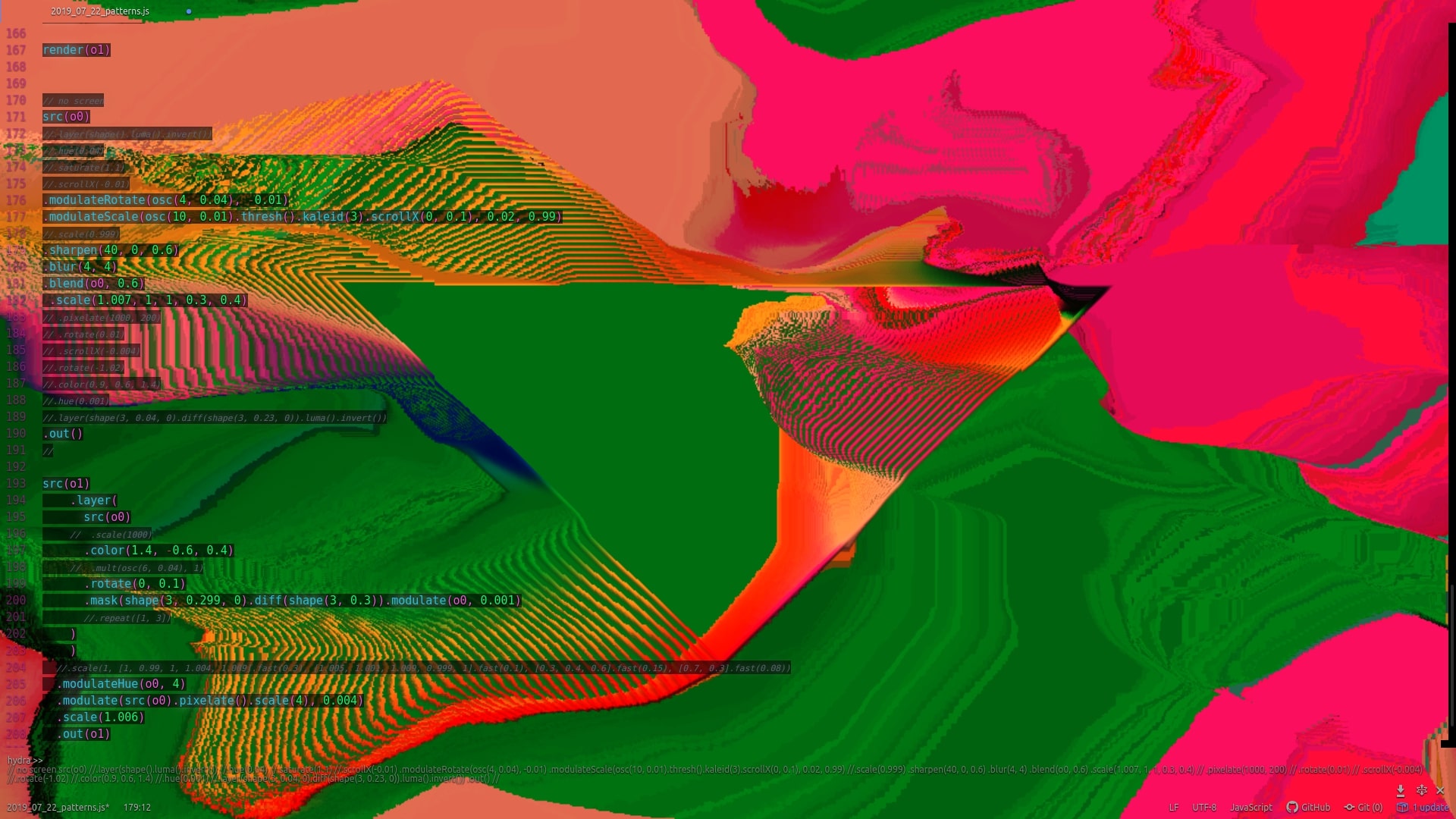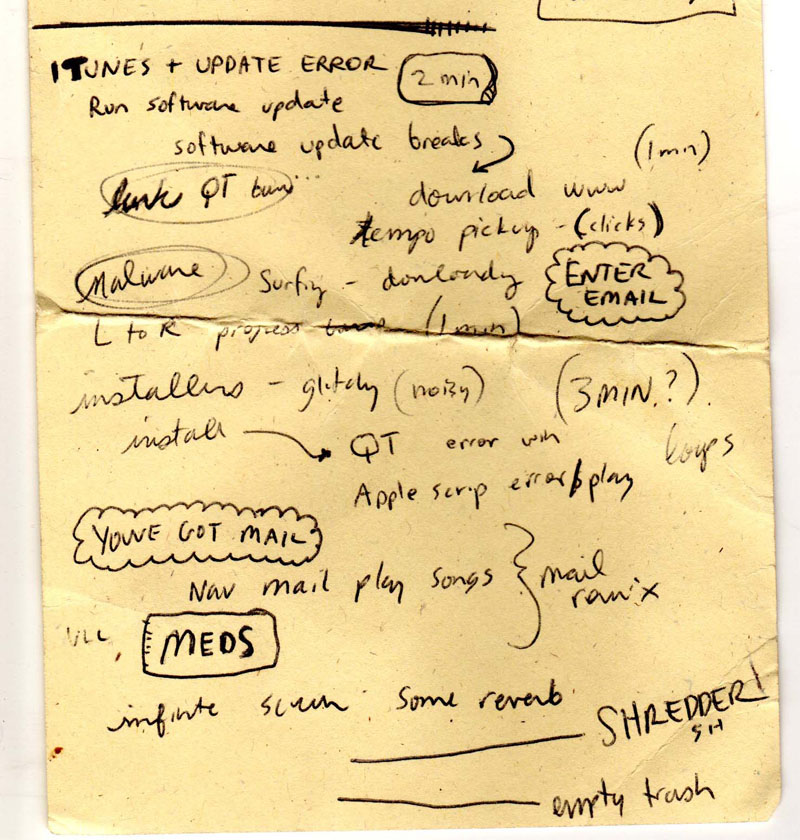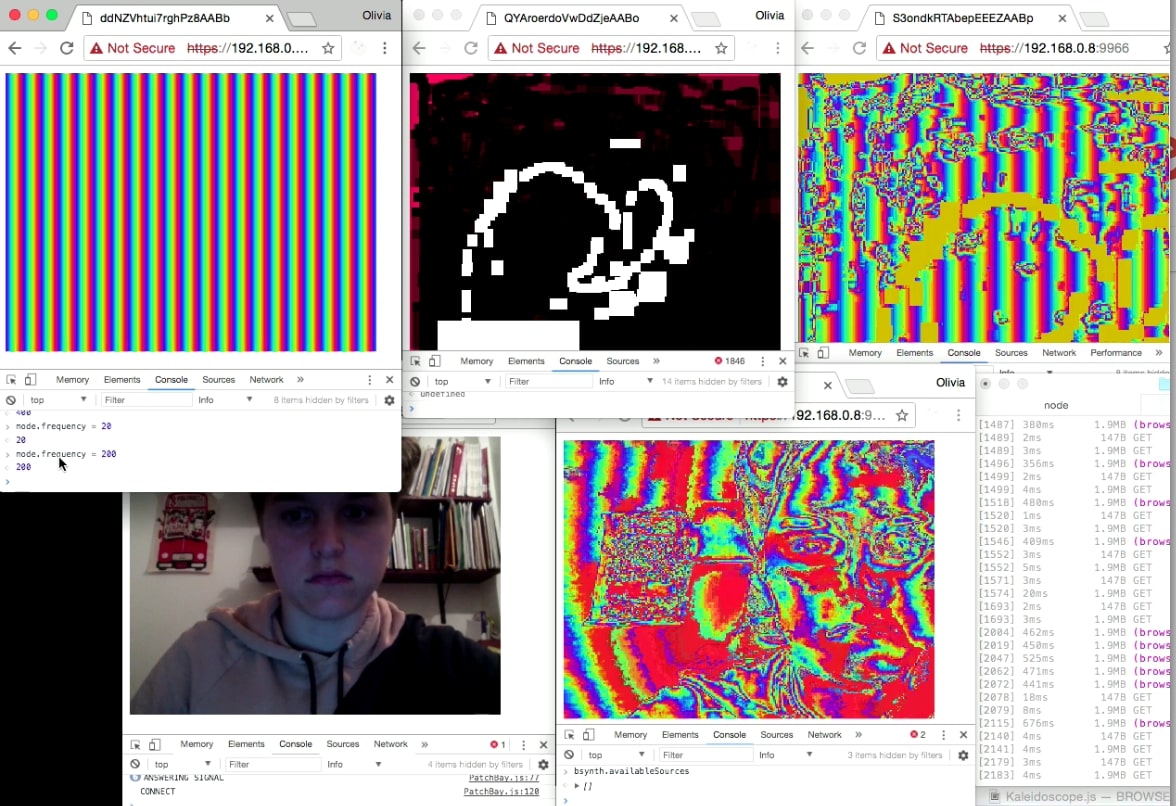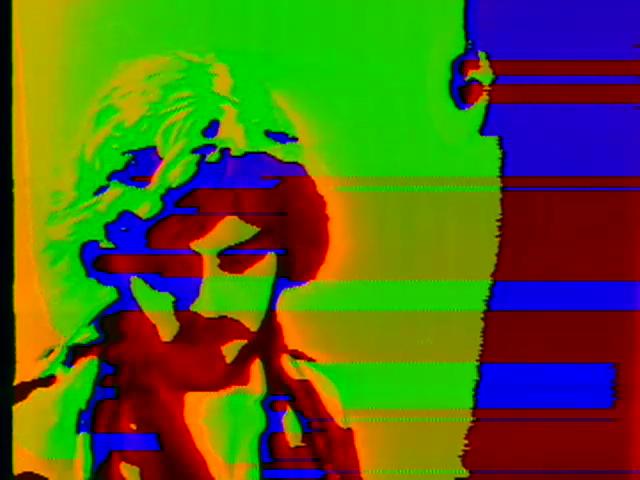Simon Denny & terra0
How do smart contracts enable nonhuman entities to govern themselves? Can the law accommodate the systems that blockchains make possible?

Glitch art is less about style or form than it is about process. Performative practices such as live coding can be a way to bring a process to the surface, to probe it, and to push its limits. Since the early 2000s, Jon Satrom has worked both collaboratively and individually to produce real-time computer-based audio and visual performances. He refers to himself not as a glitch artist but as a kludge artist, borrowing a term from computing that describes a system assembled from ill-suited parts: clumsy, difficult to maintain, a temporary fix that is liable to cause more problems in the long run. For Satrom, live performances—along with software art, and curatorial and educational initiatives—are a forum for presenting and experimenting with such systems. Olivia Jack, meanwhile, came to live code through programming. It was in 2017 that she first used Hydra, a browser-based interface she created for video mixing and routing, at a live-coding conference in Mexico, where she realized its potential as a tool for computer-based performances. Since then, a large community of users and contributors has formed around Hydra, which remains free and open source. Outland brought the two artists together to discuss their attraction to live code, as well as the historical influences that have shaped them and their plans for future projects.
OLIVIA JACK I’ve been interested in how things work since I was a kid. I wanted to be a physicist like my dad. I also really liked painting and drawing, but I didn’t see so much of a connection between the two things. Later, I ended up studying engineering, and the further I got with that the more I felt limited by the kinds of things I could make as an engineer or scientist.
I started to see these two interests intersect more as I got older. I spent a lot of time at hackerspaces in the Bay Area, which is where I grew up, and also on the internet, on places like Tumblr. I remember seeing some datamoshing tutorials when I was about eighteen and getting really excited, thinking “How does that video work?” and “What can I do with that?”
For a while I worked freelance doing media design—for dance performances, interactive installations for museums, etc.—but in terms of developing my own practice it’s mostly been a matter of making things and putting them online and then people start using them.
JON SATROM I was similarly driven by that question of “How does it work?” When I was a kid, a neighbor gave me a telephone they were throwing away, and I immediately started taking it apart before realizing I couldn’t put it back together.
But what really got me into this was a local community access television station that I stumbled upon with a friend in the basement of a library. We were teenagers but they allowed us to have a show and we were able to broadcast out to tens of thousands of people. And there were all these broken machines, equipment malfunctioning. So that got me geeked on the tech side of things, and starting to think about what I could do with all this broken stuff.
JACK A big moment for me was in 2015 when I made Pixelsynth, a browser-based synthesizer for turning images into sound. I was learning about using oscillators to make sound on a computer, and because I’m very visual I started wondering what would happen if all the oscillator frequencies were controlled by pixels. So I made this tool where you could edit the images to edit the sounds. I think it’s still one of the first results when you google “turn images into sound.”
It was momentous for me to see what happened when I shared work directly in the browser. People started to use it in all these different ways from what I had initially imagined. The web is especially exciting to me as a social context for making and sharing work, where putting even a half-finished idea online can lead to other things I never would have imagined.
SATROM Totally. One of my early projects was a group called I Love Presets that I formed with Jason Soliday and Rob Ray in Chicago in the 2000s. This was where I started to flirt with live code, but always in a clunky, messy kind of way. I’m super inspired by folks like TOPLAP, who are virtuosic about the way they approach live coding. I’m both terrified and exhilarated by showing my mouse while real-time troubleshooting. There’s a vulnerability there that one doesn’t get when nestled behind a sleek production software interface.
Jason’s thing was modular synthesis, and Rob would do more sample-based stuff. I’d be focusing on the visual side and then we’d crunch it all together. There’s very little documentation of the I Love Presets stuff because we were more concerned with being in the moment. But that’s really the origin of my desktop performances, which I’ve now been doing for a long time.
JACK I think there’s a logical link between liking to just experiment with things and then being drawn to a live process where you would experiment with things in front of other people— as opposed to a tightly choreographed performance.

SATROM For my performances, I do have a list of what I want to get through. Sometimes it doesn’t work, but I’ll plan that out and then fail through it. But I agree, there is something about the performative aspect that’s different from deploying an existing program, which is more like what would happen in a film screening.
JACK I’d been programming for a long time but I didn’t start doing more live coding until around 2016 or ’17. I participated in an artist residency at Platohedro in Medellin, Colombia, where I got to know a group of artists and hackers interested in live coding—writing code live and projecting the screen as part of an audiovisual performance.
Learning about live coding influenced how I approached programming projects after that. I started getting obsessed with the idea of being able to send live video streams to different places, and writing a lot of code for that in Javascript. I found it much more exciting to write the code in a way that enabled me to edit live and continuously explore. I’m a Libra and I can’t make decisions about anything. And so instead of making a program and having, for example, four things I can do on the interface, I ended up making a constantly reconfigurable toolbox that I can keep messing around with. That toolbox is now online as Hydra. I wasn’t thinking about performing at that moment, but it’s an approach that happens to also be interesting in performances.
SATROM I love that. It says so much about the closed nature of interfaces: how the limitations of interfaces limit opportunity and output and mediate what is made.
JACK Another important moment was attending the International Conference on Live Coding (ICLC) in Morelia, Mexico in 2017. They had this format called “from scratch,” a live coding practice that came out of a series of workshops held at the Centro Multimedia CENART in Mexico City in 2010, where everyone starts with a blank screen and has nine minutes to make something happen. I would never have done it on my own, but someone managed to convince me to do a “from scratch” performance with Hydra. So I decided to use Hydra live, which is when I first saw its potential as a performance tool.
Hydra had started as my own exploration into video mixing and routing, using the internet as a kind of modular synthesizer—and then wanting to create a sandbox for people to play with these ideas. I’ve had lots of other open-source projects which nobody ever used, but in this case, people started to use Hydra almost immediately, and there is now a large community of users and contributors. The base functionality has not changed much since 2017, but we have focused much more on supporting connections and collaborations between the community of users, and making it as easy as possible for people to hack Hydra, extend it and use it in their own projects.
That’s why Antonio Roberts and I decided to create the microgrants program. It’s a donation-based community fund that awards grants to people with a project involving Hydra—tutorials, workshops, documentation, add-ons, and so on. The idea is to support these types of contributions and ideas as much as we support the coding aspects of software development.

SATROM That’s awesome. Nerds like us have a proclivity for geeking out on structures. And I find it exciting when you’re building out a social structure—a community or a curriculum or a festival or a non-profit—in the same way you might approach a piece of artware. An example like this for me was GLI.TC/H, which we first held in Chicago in 2010. We knew we wanted it to be a festival, but what does that mean? What kind of outputs are people making? We embraced all possible contexts and ended up doing a gallery show, we did talks, we did performances, screenings.
Earlier this year, I did a desktop performance at a film festival called Cosmic Rays. Halfway through, the audience figured out that my Airdrop was on and people started airdropping me videos that they were taking of the performance. I started accepting every Airdrop and it crescendoed into a beautiful moment. It messed with time, messed with participation.
When I talk about my own work, I tend to dance around the word “glitch”—I prefer “kludge.” It’s an engineering term for an inelegant solution to a problem. It’s a wet band-aid, or tape, or glue, or spit. It might make something a less catastrophic failure—so not a hardcore glitch—but it also presents more opportunities for smaller failures, which is why I gravitate toward it. In my mind, failure is an opportunity to either rebuild or change directions.
There’s also a level of humor or silliness to kludge. Technology is often built to make us feel like we can’t understand it, like we have no control over it. If we can laugh at these devices that we call “smart,” if we can make them do something dumb or absurd, I think there’s a level of power or agency that we can regain.
JACK The notion that technology is set up to make us feel dumb really resonates with me. Also, the culture around learning to use technology is usually set up to make you feel like if you didn’t come out of the womb with a terminal in front of you, then you could never program anything. I find it really refreshing to be able to just play around—with code, with physical hardware, with desktop apps—and see what happens instead of reading a whole manual or learning semesters of linear algebra and programming theory before writing a piece of code.
There’s a quote from Dan Sandin, who made a video synthesizer called the Sandin Image Processor in the 1970s, where he says “Put yourself in a feedback loop.” He’s talking about video feedback but also feedback as an artistic practice, where you do something and you see what happens and you do something else based on that—and how this process is really different from just doing something and putting it out as a finished product.

SATROM The Sandin quote I always use is, “Every process in the universe is a series of input processes and outputs.” I love that as an expanded view of everything.
The approaches and experimentation of early video pioneers like Woody and Steina Vasulka were very inspiring to me when I was starting out at the TV station. That, plus the software art or artware of people like Adrian Ward, who made the Adobe software parodies Autoshop (1999) and Auto-Illustrator (2001)—programs that were built with ideas of play, with jokes for you to discover and experiment with. I could only hope to be positioned alongside kind of stuff. But I have been lucky enough to share the stage with some of these folks.
JACK I have similar references in early video—the Vasulkas, and also Kit Galloway and Sherrie Rabinowitz, who were doing all this work exploring satellite transmission before the internet existed. In 1980 they made Hole in Space: A Public Communication Sculpture, which connected two screens on the East Coast and the West Coast via a live two-way transmission.
Aesthetically, I’m also really inspired by painting. I like the way painting layers a lot of imprecise things on top of each other, rather than the clean lines and drawings of instructional art. But then of course there are people like you and Nick Briz and Rosa Menkman and Shawné Michaelain Holloway—the Chicago scene.
SATROM Speaking of: shall we talk about this experiment that you’re coming to Chicago for?
JACK Yeah!
SATROM So, this nonprofit artist collaborative called Netizen that Nick Briz and I founded a few years ago is working to bring you to Chicago. I don’t know what we’re calling it but it’s going to be a series of conversations around Hydra, live code, and the video synthesizers of the 1960s and ’70s. The output might be these conversations, but one of the goals is also to incubate some software art coming out in the near future. I don’t know if I’ve told you before, but I’m a super fan of your work.
JACK And I’m a super fan of yours, so it’s very exciting.
—Moderated by Gabrielle Schwarz.
